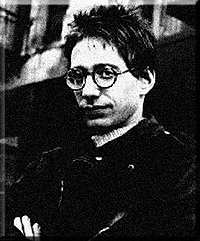|
|
|
| John Zorn : |

| Man |
| and |
Saxophone |
|
It is possible to call John Zorn a "jazz" musician, but that would be much too limiting a description. While jazz feeling is present in a good deal of his work, and the idea of improvisation is vitally important to him, Zorn doesn't operate within any idiom's framework, drawing from just about any musical, cultural or noise source that a fellow who grew up in the TV and LP eras could experience. This eclecticism gone haywire can result in such wildly jump-cutting works as Spillane, whose plethora of diverse and incompatible styles makes for a listening experience akin to constantly punching the station buttons on a car radio. Zorn believes that the age of the composer as an "autonomous musical mind" had come to an end in the late 20th century; hence the collaborative nature of much of his work, both with active musicians and music and styles of the past. Like Mel Brooks, the zany film director, many of Zorn's works are tributes to certain musical touchstones of his -- such as Ennio Morricone, Sonny Clark and Ornette Coleman -- all filtered through his unpredictable hall of mirrors. While it would be foolhardy to single out a handful of dominant influences, Zorn's music seems very close in spirit to that of Warner Bros. cartoon composer Carl Stalling, both in its transformation of found material and manic, antic moods. This calculating wild man started playing the piano as a child before taking up the guitar and flute at age ten. By the time he was 14, Zorn had discovered contemporary classical music and began composing; his college years in St. Louis brought about his introduction to avant-garde jazz, particularly that of Anthony Braxton. He dropped out of college, settled in lower Manhattan, and began working with free improvisers, rock bands, and tape, sometimes working duck and bird calls into his arsenal. After putting out releases on tiny domestic and poorly distributed import labels, Zorn signed with Elektra-Nonesuch in the mid-'80s, which increased his visibility considerably. Along the way, he has formed tribute bands to play the music of Coleman, Hank Mobley, Lee Morgan and others; featured musicians as diverse as Big John Patton, Tim Berne, Bill Frisell and the Kronos Quartet; and assembled a group called Masada that merges Coleman with Yiddish music. Jazz buffs should be directed to his Coleman tribute album Spy Vs. Spy (Nonesuch), which makes exciting, thrashing yet concise hashes of 17 Ornette tunes with a quintet. Cartoon S&M followed in fall 2000. Songs from the Hermetic Theatre appeared a year later. -- Richard S. Ginell 
|
